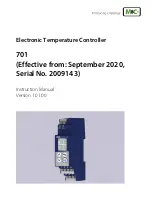
Geophysical Survey Systems, Inc.
SIR® 30
Manual
MN 93-101 Rev E
44
Note:
At shorter time ranges (< 100 ns) GSSI recommends operating the gain mode in AUTO for initial
gain set up. The User may then change to Manual if desired. When operating the system with Low
frequency antennas (> 200 MHz) or at extended time ranges (> 200 ns) GSSI recommends using a larger
number of Gain Points (> 5). This will speed up the antenna initialization process.
SIGNAL PROCESS > IIR FILTERS
The SIR 30 system utilizes both IIR and FIR vertical and horizontal filters for noise reduction and signal
conditioning. IIR stands for ‘Infinite Impulse Response’. These are a class of digital filters that have an
impulse response function that is non-zero over an infinite amount of time. A single pole Butterworth
design is used for both the Low Pass and High Pass IIR filters. The User only has to specify the desired
high pass and low pass cut off frequency in megahertz. The IIR vertical filters have excellent amplitude
response, however they have a non-linear phase response so they can cause slight time shifts in the signal.
For most applications this shift is insignificant as the actual time shift as a percentage of the total recorded
time is very small, however when collecting data with high frequency antennas over very short time ranges
(5 - 10ns) the phase shift may be a non-trivial percentage of the total two-way time.
LOW PASS IIR:
This is a vertical filter. The value is expressed in frequency (MHz). A low pass filter will
pass everything lower than the specified frequency so this number should always be higher than the center
frequency of the antenna. The purpose of the low pass filter is to remove high frequency noise in the data.
Common GSSI default values are 2 times the antenna’s center frequency e.g. 800 MHz for a 400 MHz
antenna.
HIGH PASS IIR:
This is a vertical filter. The value is expressed in frequency (MHz). A high pass filter will
pass everything higher than the specified frequency so this number should always be lower than the center
frequency of the antenna. The purpose of a high pass filter is to remove unwanted low frequency noise.
Commonly GSSI default values are between 1/4 to 1/3 the antenna’s center frequency e.g. 100 MHz for a
400 MHz antenna.
Note:
GSSI recommends applying an IIR High Pass filter during data collection, as it will remove low
frequency noise prior to the application of gain. The User may then apply IIR and\or FIR filters as needed.
STACKING:
This is a horizontal or spatial filter. The value is expressed in scans. This filter is a running
average filter used to remove horizontal features that are of short spatial duration. This will smooth the
data and reduce random noise, particularly at greater time ranges. This filter value should be set very low,
as high values will remove features of interest from the data. Commonly used values are 3-7 scans.
IIR BACKGROUND REMOVAL:
This is a horizontal or spatial filter. The value is expressed in scans. The
background removal filter is a horizontal Low Pass filter that works by subtracting a running average
number of scans from the data and outputting the results. This filter has the effect of removing flat lying
features that are longer than the specified filter window (in scans). These may include the direct coupling
and any other signal in the data that is time constant or relatively time constant. This filter is very useful
for removing flat, horizontal noise bands in the data. This filter value should be set very high. GSSI
recommends that a value of 1023 scans be used.
Note:
The User should use care when applying a Background Removal filter. While the Background
Removal filter is useful for removing ringing bands from the data it can also removal real horizontal or sub
horizontal features of interest such as layer or other structural interface reflections.
Содержание SIR 30
Страница 1: ......
Страница 4: ...Geophysical Survey Systems Inc SIR 30 Manual ...
Страница 6: ......
Страница 90: ...Geophysical Survey Systems Inc SIR 30 Manual MN 93 101 Rev E 84 ...
Страница 102: ...Geophysical Survey Systems Inc SIR 30 Manual MN 93 101 Rev E 96 ...
Страница 120: ...Geophysical Survey Systems Inc SIR 30 Manual MN 93 101 Rev E 114 ...
Страница 122: ...Geophysical Survey Systems Inc SIR 30 Manual MN 93 101 Rev E 116 ...
Страница 144: ...Geophysical Survey Systems Inc SIR 30 Manual MN 93 101 Rev E 138 Figure 168 SIR 30 Cable Pin out ...
Страница 145: ...Geophysical Survey Systems Inc SIR 30 Manual MN 93 101 Rev E 139 Figure 169 Cable Selection Guide ...
Страница 146: ...Geophysical Survey Systems Inc SIR 30 Manual MN 93 101 Rev E 140 Figure 170 Survey Wheel and Model 10 Marker Pin Out ...
Страница 147: ...Geophysical Survey Systems Inc SIR 30 Manual MN 93 101 Rev E 141 Figure 171 Serial Port GPS Pin out ...
Страница 148: ...Geophysical Survey Systems Inc SIR 30 Manual MN 93 101 Rev E 142 ...
















































